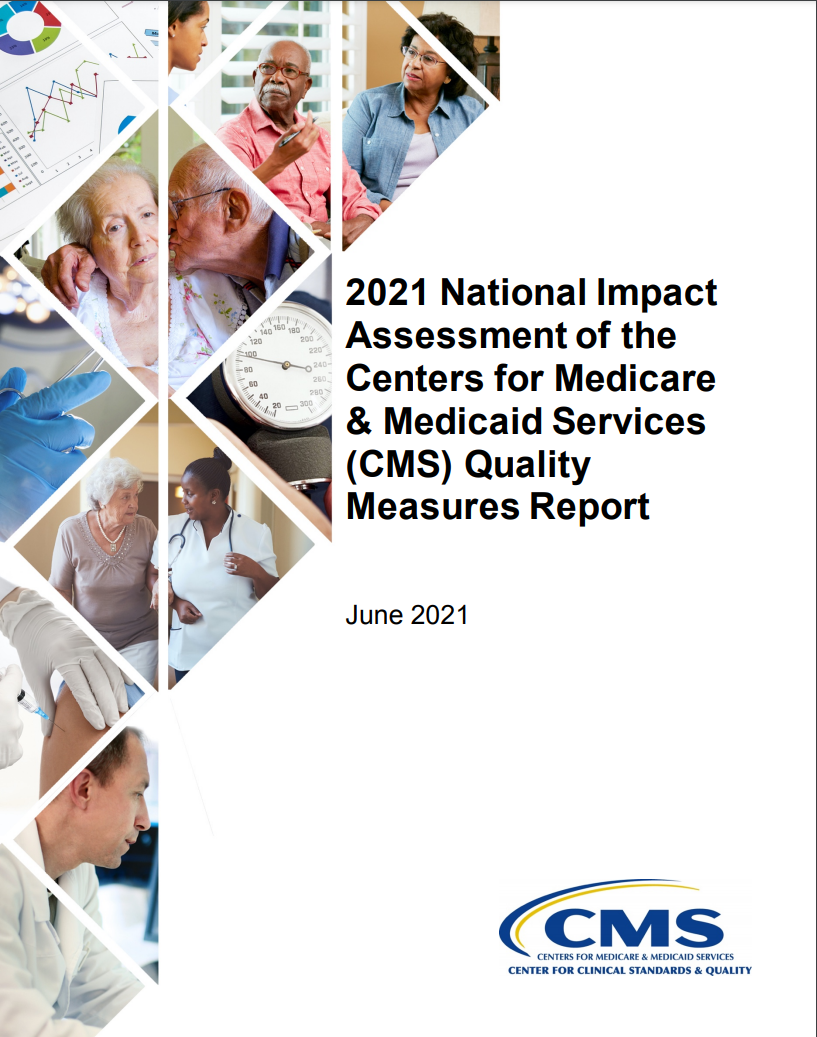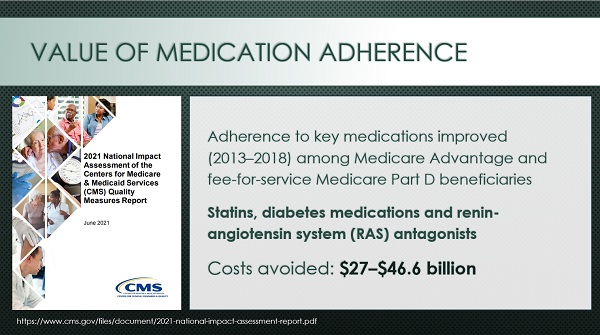Medication Adherence Measures Help Medicare Beneficiaries Avoid Up to $46.6 Billion in Health Care Costs
What is the impact of the three medication adherence measures used in the Medicare Part D Star Ratings program?
Enormous.

The 2021 National Impact Assessment of the Centers for Medicare & Medicaid Services (CMS) Quality Measures Report, released in June, estimates that $27–$46.6 billion in health care costs were avoided for Medicare beneficiaries between 2013-18 thanks to improved patient adherence to medications for diabetes, hypertension and cholesterol.
The Pharmacy Quality Alliance (PQA) developed and stewards the three Star Ratings measures that evaluate adherence for diabetes medications, hypertension (renin-angiotensin system antagonists) and cholesterol (statins). PQA is the national quality organization dedicated to improving medication safety and appropriate use.
These conditions are major drivers of serious illness, disability, death and health care costs in the United States. Consider these estimates:
- The total estimated 2017 cost of diagnosed diabetes of $327 billion includes $237 billion in direct medical costs and $90 billion in reduced productivity, according to the American Diabetes Association.
- Having high blood cholesterol raises the risk for heart disease, the leading cause of death, and for stroke, the fifth leading cause of death, according to the CDC. Nearly 80 million American adults could benefit from cholesterol-lowering medicine.
- High blood pressure costs the nation $48.6 billion each year. This total includes the cost of health care services, medications to treat high blood pressure, and loss of productivity from premature death, according to the CDC.
A healthy lifestyle and the use of appropriate medications are key for prevention and control strategies related to these health conditions.
The CMS impact report is strong evidence that medication adherence and PQA’s performance measures play an important role in improving care and controlling costs. The estimated cost savings also counter some arguments against Part D’s use of these adherence measures.
Background on PQA’s Measures
PQA’s health plan medication adherence measures examine individuals’ prescription claims for specific classes of medication therapy, based on the well-accepted proportion of days covered (PDC) methodology. Patients are most likely to achieve clinical benefit from the medication if they have a filled prescription for the medication – or another medication in the same therapeutic class – 80% of the time within a measurement year.
PQA’s PDC-based performance measures are classified by CMS as intermediate outcomes measures. PDC measures cannot confirm whether patients take medications as prescribed. However, they provide important insights into how often patients have medication available to take. When you consider the enormous, estimated costs avoided in the CMS impact report, it is reasonable to conclude that these measures effectively evaluate health care activities that correlate with positive health outcomes.
Digging Deeper on CMS’ Impact Analysis

The CMS report provides estimated costs avoided for each of the three PQA adherence measures, as well as the increased number of patients who were adherent to the medication from the 2013 baseline. These estimates are for Medicare Advantage (MA) and traditional fee-for-service Medicare beneficiaries with Part D:
- Statins: 4.0 million more beneficiaries than expected; costs avoided of $5.4–$13.7 billion.
- Diabetes medications: 893,811 more beneficiaries than expected; costs avoided of $3.4–$7.2 billion.
- Renin-angiotensin system (RAS) antagonists, including angiotensin-converting enzyme inhibitors and angiotensin-receptor blockers: 3.0 million more beneficiaries than expected; costs avoided of $18.2–$25.7 billion.
PQA medication adherence measures also play a role in addressing health equity. The report notes that disparities in medication adherence narrowed for Black, Hispanic, and low-income MA beneficiaries during this period. That’s good news, but we know more can be done to close adherence gaps. PQA is committed to addressing health disparities in medication use quality. Both CMS and the National Committee on Quality Assurance are exploring approaches to address inequities in care, including the stratification of quality measures to highlight disparities and opportunities for improvement. PQA similarly is considering ways to promote health equity through performance measurement. It is part of our developing strategic plan, and we’ll share more on this work in the coming months.
Supporting medication adherence, CMS also reported that 3.3 million more Part D beneficiaries with complex health needs than expected between 2013-2018 received a comprehensive medication review as a part of medication therapy management. Importantly, “disparities detected in 2013 were no longer evident for MA beneficiaries living in micropolitan, medium metro, small metro, and noncore (rural) areas and for those with middle income.” Disparities also narrowed for those with dual Medicare-Medicaid eligibility status and for Asian and Hispanic beneficiaries.
This is not the first time CMS has estimated tremendous cost savings thanks to Medicare beneficiaries’ medication adherence. The 2018 impact assessment report estimated $4.2-26.9 billion in health care costs avoided from 2011-2015, based on analysis of these same three PQA measures. The 2021 report demonstrates that adherence continues to improve, and by association costs avoided are increasing.
Mitigating unnecessary health care costs, such as avoidable hospitalizations and unplanned readmissions, are an important part of delivering high-quality care and ensuring that our care systems remain financially stable and solvent.
Medication Adherence and Value-Based Care
The safe and appropriate use of medicines has great value for everyone in health care. If you’re a physician, hospital or health system, medication adherence supports improved performance on the quality measures for which you are accountable. A 2019 study in The American Journal of Managed Care concluded that there is a clear relationship between average medication adherence and patient health outcomes as measured at the physician level.
If you’re a pharmacist, this report highlights your role to improve health outcomes for patients and to reduce care costs. Community pharmacist-led interventions have been shown to improve patients' adherence and contribute to better blood pressure control, cholesterol management, chronic obstructive pulmonary disease and asthma control, according to a 2018 International Journal of Pharmacy Practice article.
To evaluate pharmacists’ contributions to care, PQA is developing pharmacy performance measures that would be appropriate for accountability in value-based arrangements. Distinct from the claims data-based health plan measures used in Part D that are described above, these measures will use pharmacy system data and other clinical data to evaluate pharmacist-provided care.
A PQA multi-stakeholder expert panel is developing a pharmacy PDC composite measure that parallels the Part D health plan adherence measures for diabetes medications, hypertension and cholesterol. This measure is on track to be developed by the end of 2021. Once assessed against standard measure criteria and endorsed by PQA membership, it will be appropriate for use in plan-pharmacy, value-based agreements.
PQA’s development of pharmacy measures is responsive to CMS proposals and congressional proposals (including H.R. 3, H.R. 19, H.R. 3554, S. 1909) to create “standard pharmacy quality measures.” Importantly, PQA’s measures will provide an opportunity to align incentives for health plans and pharmacists. That may drive additional improvement and close gaps in medication adherence and patient outcomes.
Richard Schmitz is the Chief Engagement Officer for the Pharmacy Quality Alliance, a national non-profit quality organization that was initially created by CMS as a public-private partnership in 2006. He oversees PQA’s member and stakeholder engagement efforts, education, communications and meetings. PQA has 250 member organizations across health care.
This blog was first published online by Pharmacy Times.
